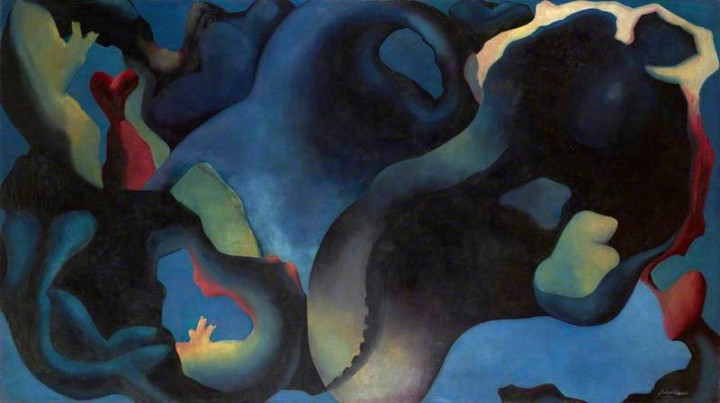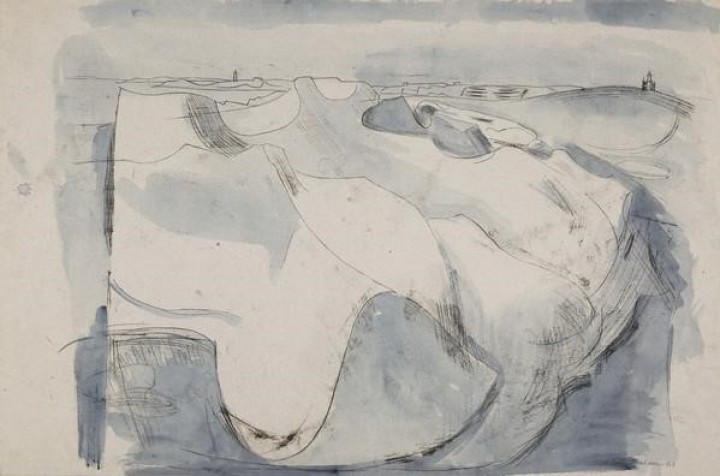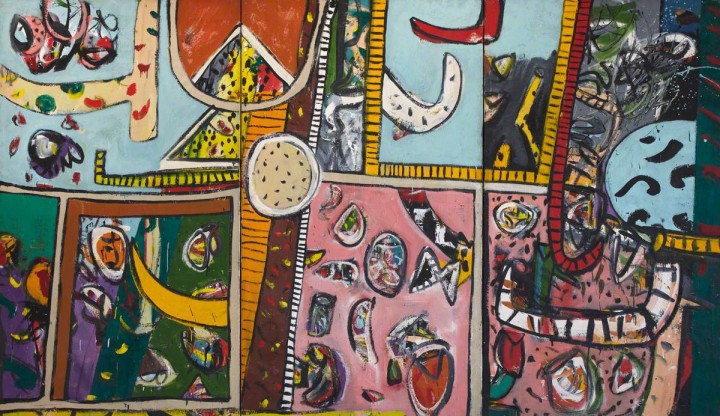Scottish Art News
Latest news
Magazine
News & Press
Publications
A Point In Time - The Eternal Now
By Bill Hare, 01.09.2017

It may come as a surprise to many of my fellow Scots that there is such a thing as a history of abstraction in Scottish modern painting. Not that they are really to blame, for there has never been any marked recognition of this particular history, either through a major publication or exhibition. There have, of course, been numerous exhibitions and accompanying catalogues on the work of individual Scottish abstract painters; I have curated and written some myself, but their artistic achievements have been seen in relative isolation, and never within the wider context of a recognised history of Scottish abstract art.
When are we to be given the opportunity to see, admire and celebrate the particular nature and specific history of abstraction in Scottish modern painting? Who knows. This article aims to go some way to rectify this lamentable neglect and to tell the story of Scottish abstract art on the page, if not the gallery walls.
It was a Scottish artist, William Johnstone, who in the 1920s did more than any other to introduce and pioneer the art of abstract painting in Britain. As much a radical modernist as his great friend, the poet Hugh MacDiarmid, Johnstone was committed to creating a new dimension in the language of modern painting. The inspiration for the art of both painter and poet was rooted in the landscape of their native Borders hills, but they were also committed internationalists. Thus Johnstone’s career was one of much travel; constantly going from his homeland and returning to it. Firstly, to Paris in the mid-1920s where he came in direct contact with European modernism – there he encountered and became deeply involved with surrealist biomorphism which allowed him to develop a deeper psychological relationship with his atavistic feeling for landscape. ‘I am part of nature and nature is part of me,’ said Johnstone.
He was also one of the first British artists to work in America and, long before Jackson Pollock, he discovered Native American art and noted commonalities with Pictish / Celtic art. ‘When I studied those... paintings,’ he said, ‘so simple, with such depths of intensity in the abstract patterns, I was reminded of the old Scottish and Pictish carved stones.’ The abstract paintings which Johnstone evolved from the late 1920s onwards became an eclectic mix of modern and ethnic sources. Furthermore, he worked on an epic scale for the time, with such paintings as A Point in Time (1929–37), which critic Paul Overy was later to describe as ‘a masterpiece of surrealist-abstraction unrivalled in scale and ambition in British painting in the 1930s’. Johnstone continued to develop his abstract painting throughout his long career, adapting different approaches and experimenting with new techniques, but almost always using nature as his primary source of inspiration.
 Wilhelmina Barns-Graham, White Rocks, St Mary's, Scilly Isles, 1953. Image courtesy the National Galleries of Scotland. Ⓒ The Barns-Graham Charitable Trust.
Wilhelmina Barns-Graham, White Rocks, St Mary's, Scilly Isles, 1953. Image courtesy the National Galleries of Scotland. Ⓒ The Barns-Graham Charitable Trust.
In the immediate post-war period, three Scottish painters shared a similar attitude and approach as Johnstone to their own abstract painting. They were Wilhelmina Barns-Graham, Joan Eardley and William Gear. All of them used their experiences of natural phenomenon, be it geological or meteorological, as the starting point for their highly personal approach to abstract painting. As Barns-Graham succinctly put it, ‘I’m very affected by nature. Nature is a tremendous informer.’ Barns-Graham in Cornwall and Eardley at Catterline both painted within their chosen coastal environments. The former took rock formations as the impetus for much of her St Ives work, while the latter preferred to confront the sublime power of the North Sea and capture its awesome force in the bold sweeping gestural brushstrokes of her late abstract expressionist paintings such as Sea and Snow, Catterline (c. 1958). By contrast, Gear sought to capture on canvas the intangible aspects of nature – like shifting sunlight and shadow – and abstract these fleeting effects into complex rhythmic patterns of highly coloured decorative compositions in dazzling paintings such as Autumn Landscape (1950).
All the painters mentioned so far can be seen as ‘soft’ abstractionists where, as indicated by the titles of their works, there is a traceable connection between their paintings and some specific aspect of the natural world. Alan Davie’s work, however, is more problematic. Being a mystic, as were all the early European pioneers of abstraction, Davie did not see himself as an artist at all – ‘I don’t practice painting as an art but as a means to enlightenment,’ explained Davie. On the other hand, whether consciously or not, he drew deeply upon the conventions and language of post-war abstract painting. In particular, Davie‘s paintings of the 1950s and 60s, when he was hailed in The Times as ‘the most remarkable British artist to emerge in recent years’, were closely associated with surrealist automatism and abstract expressionism, both of which involve a loss of ‘self’. As Davie exclaimed: ‘The work of art seems to be something thrown off – a by-product of the process of being and working.’ His most powerful paintings do have that raw immediacy of some newly formed creation just coming into being, such as in Kaleidoscope for a Parrot (1966).
Alan Davie and William Turnbull were both recruited by William Johnstone to teach at the Central School of Arts and Crafts in London in the 1950s, though there was little love lost between Davie and Turnbull. They did, however, share a very open approach to their artistic practice, based on intuition and improvisation. ‘I’ve never believed in planning what I am going to make,’ was Turnbull’s working mantra; but while Davie saw pictorial space in cosmic terms, Turnbull thought about space as ‘almost an object’. This attitude clearly reflects Turnbull’s dual role as a sculptor / painter who always thought of paintings in three dimensions. After his early, highly simplified ‘Head’ paintings, Turnbull became a truly ‘hard’ abstractionist whose paintings after 1957 ‘don’t refer to anything else, only to themselves’. Turnbull described his highly innovative and challenging paintings, which are just titled by date and numbers, as ‘a dialogue between the artist and his material’ where the truly epic scale of his all-over monochrome canvases ‘acts outwards into our world’. Turnbull was greatly admired by leading critics, such as Lawrence Alloway and Frank Whitford, who regarded him as a key-figure in the development of British painting in the 1960s.
Throughout the next decade or so, most of the serious abstract painting by Scots was carried out in London. Four Scottish abstract painters – Douglas Abercrombie, Alan Gouk, John McLean and Fred Pollock – were all associated with the studios at Stockwell Depot, a former brewery in south London, and the important annual abstract painting and sculpture exhibitions held there. They were each engaged, in their different ways, with their own individual response to the recent American post-painterly abstraction of Morris Louis, Kenneth Noland and Jules Olitski. But, as McLean put it, ‘they’ve done their paintings and we ought to be able to do ours, and still acknowledge that what they’ve done is good.’ They were visited in their studios and supported and encouraged by the leading champion of abstraction at the time, Clement Greenberg. In a letter to McLean, Greenberg reinforced his high opinion of the ‘Stockwell Scots’, writing: ‘I remain intrigued by the fact that it’s the four Scots at Stockwell, along with [Jennifer] Durrant, that are alone in England – if not in Europe – in bearing down on painting as a high art.’
 Alan Davie, Kaleidoscope for a Parrot, 1966. University of Edinburgh. © the Artist's Estate.
Alan Davie, Kaleidoscope for a Parrot, 1966. University of Edinburgh. © the Artist's Estate.
Their ‘seriousness’ was made manifest in their determination to develop their own independent and individual engagement with recent aspects of formalist abstract painting. Gouk, for instance, strove in his painting to ‘allow colour maximum richness in relation to surface through painterly facture’, while Pollock, whose painting was greatly admired by Anthony Caro, took a more sculptural approach. ‘My work must contain an illusion of the third dimension, giving a sense of some colours projecting forward from the picture plane and others appearing to recede,’ Pollock explained. At the same time, John McLean experimented with a range of painting techniques to create a directness of application and lightness of touch that is pure sprezzatura. As he said of his work, ‘there is nothing about my paintings that, if you look hard enough, you cannot see for yourself. They are not obscure. Their directness hides all the hard work.’
About the same time in Scotland, there began to emerge a very different approach to abstract painting. One of the main impulses for this was a strong reaction among the younger Scottish artists against the belle peinture style which had dominated modern painting in Scotland since the colourists. This new generation sought a radical alternative through minimalist abstract painting. Like Turnbull, they wished ‘to charge the canvas with maximum meaning through the minimum of means’.
An important exponent of this highly austere and intense approach was Kenneth Dingwall who painted with a self-imposed narrow range of colours; blue, red, black and grey, all of which in his painting alluded to and evoked profound emotional associations. Although much of his work appeared to be monochrome, on closer examination, little breaks in the paint revealed layers of different colours underneath the final surface, suggesting hidden depths of complex feeling and profound expression. As the critic Paul Overy observed on this delayed effect, ‘Dingwall’s paintings give little away at first. Meanings seep out of them slowly.’
Another abstract artist from this period who also evolved a highly pared-down attitude to his art was Alan Johnston. Using the simplest and most direct approach – pencil markings on a canvas or a wall, held together within some loose non-Euclidean geometric shape – Johnston’s minimal interventionist approach required highly perceptive and sensitive awareness in the attentive viewer. Johnston’s fugitive and ethereal art, forever hovering between presence and absence, the visible and invisibility, emanated from a wide range of philosophical and esoteric sources; from Merleau-Ponty’s phenomenology to Japanese Zen.
 Callum Innes, 2. Image courtesy the National Galleries of Scotland, the Henry and Sula Walton Collection, bequeathed 2012. © the artist's estate.
Callum Innes, 2. Image courtesy the National Galleries of Scotland, the Henry and Sula Walton Collection, bequeathed 2012. © the artist's estate.
In contrast to Johnston’s graphic approach, Callum Innes’ art is deeply concerned to reveal the physical properties of paint as a material substance. Innes prefers to work in ongoing series which are differentiated by the complex process of their making; for example, his Exposed Paintings – as the name implies – are as much about removing colour pigment as applying it. Innes’ finely balanced approach to painting involves intuition and experimentation, accident and control, yet with the ultimate aim, ‘to create an image that is somehow natural, that exists in its own right’.
In 1998, Innes was part of a multi-national group exhibition at the Houston Contemporary Arts Museum, Texas, entitled Abstract Painting, Once Removed. The exhibition set out to show that good abstract painting was now being produced anywhere and everywhere across the globe – even in Scotland. Unlike their predecessors, Dingwall, Johnston and Innes were, and still are, all based in Scotland. Today, there is a whole generation of younger and emerging artists working in Scotland who are investigating and extending, in their own individual way, the range and creative possibilities of contemporary abstract painting; from the intriguing organic pictures of Abstract Critical prize-winning, Glasgow-trained Zara Idelson to the ‘everyday’ abstraction of Edinburgh graduate Kevin Harman’s double-glazing window constructions.
Abstraction for Scottish artists came later than for their European counterparts. Unlike the pioneers of abstract art, the Scots were hardly touched by the mystical or utopian ideals that dominated the early stages of European abstraction – ‘Paths to the Absolute’ as the eminent modern art scholar and abstractionist, John Golding, described it. By contrast, the Scottish abstract painters were rarely motivated by Platonic ideals. They were much more Aristotelian in their outlook; less concerned with the transcendental and immutable, more with the immediate phenomenological impact of colour, shape, texture, and scale on the human senses – what William Turnbull termed the ‘eternal now’. For inspiration, they preferred to look to nature and their own place in it – even Alan Davie took some of the impetus for his art from flying and swimming – rather than seeking the expression of some otherworldly experience.
The historian Christopher Kissane recently wrote in The Guardian that, ‘historians must take it upon ourselves to increase our engagement with broader audiences, spreading awareness of the content, diversity and importance of our work.’ This equally applies to art historians and art institutions. The aim of this essay is not to enhance the reputations of these important Scottish abstract painters – individually they hardly need it, as seen from the critical responses quoted throughout. However, there has never been an opportunity for Scottish audiences to view work by these pre-eminent artists alongside each other, in an exhibition that tells the remarkable story of Scottish abstract art – much would be gained by viewing their works in this context.




